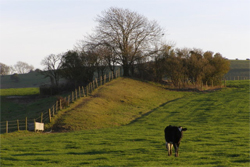Neolithic 4000 - 2500 BC
For much of the Neolithic and indeed the Early Bronze Age evidence for settlement and sedentism (living permanently in one place) is lacking.
The Neolithic period sees the introduction of pottery, domesticated livestock and cereal cultivation. However agrarian landscapes were later to develop and there is no evidence for Neolithic field systems within the AONB.
The AONB, and especially the Cranborne Chase, is well known for the concentration of Neolithic 'monuments'.

Long Barrows are some of the earliest monumental features forming communal burial places for often disarticulated bone from multiple individuals. There are 39 long barrows known within the AONB.
The Photograph is of a Neolithic Long Barrow on Bokerley Down.
(Copyright Jim Champion licensed for reuse under a Creative Commons license.)
The Dorset Cursus with a date of around 3,300 BC is a nationally important Neolithic monument consisting of a of a pair of parallel banks (1.5 m tall) running about 82 m apart, with external ditches. It runs for approximately 10 km. It remains enigmatic but the first phase Gussage terminal is aligned on the Midwinter sunset.
Another key monument type is Causewayed Enclosures. These are are often located on hilltop sites, encircled by one to four segmented concentric ditches, with an internal bank that is also segmented. There is one causewayed enclosure on the AONB on the spur of Whitesheet Hill.
There is a nationally important late Neolithic Monument complex at Knowlton which has recently been the focus of a research project by Bournemouth University. This consists primarily of massive earthwork enclosures (henges) up to 220m across and often associated with other Late Neolithic monuments such as timber circles and monumental mounds. Another complex of monuments including two long barrows has also been recently discovered at Damerham. See the project website.
Environmental Evidence - The environment of the Wessex chalklands has been more intensively studied than in other areas. The general pattern seems to be that clearance of the woodland of the Wessex Chalkland occurred earlier in lowland locations than on the tops of the downs. Early Neolithic clearance seems to have been primarily for pasture. By the Late Neolithic the area of pasture had been expanded and there is limited evidence for corresponding expansion of arable agriculture.By 3000BC the Wessex chalklands were intensively exploited and Late Neolithic monuments were associated with grassland.
This document forms part of the wider AONB Historic Environment Action Plans.
